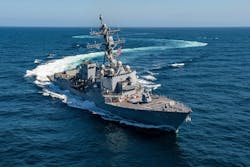DRS Laurel to build AN/USQ-82(V) fiber-optic shipboard networking for U.S. Navy's Burke-class destroyers
Questions and answers:
- What equipment is the U.S. Navy ordering from DRS Laurel Technologies? The AN/USQ-82(V) Gigabit Ethernet Data Multiplex System (GEDMS) hardware and spare parts for new and upgraded Arleigh Burke-class destroyers.
- What is the purpose of the AN/USQ-82(V) shipboard networking system? It provides a mission-critical, redundant IP-based backbone that transfers data for systems such as machinery control, damage control, steering, navigation, and the Aegis combat system.
- How does the AN/USQ-82(V) improve ship operations compared to traditional copper cabling? It replaces miles of point-to-point wiring with a fiber-optic backbone, reducing manpower needs, improving crew safety, and enabling advanced multimedia services like video and data transmission.
WASHINGTON – Military communications experts contract manufacturer DRS Laurel Technologies in Johnstown, Pa., will provide the U.S. Navy with fast shipboard networking equipment under terms of an $11.5 million order announced at the end of July.
Officials of the U.S. Naval Sea Systems Command in Washington are asking Leonardo DRS for AN/USQ-82(V) Gigabit Ethernet Data Multiplex System (GEDMS) hardware and spare parts new and upgraded Arleigh Burke-class destroyers. Leonardo DRS is a subsidiary of Leonardo DRS Inc.
The AN/USQ-82(V) family of shipboard networking systems consists of the Data Multiplex System (DMS), the Fiber Optic Data Multiplex System (FODMS), and GEDMS.
The AN/USQ-82(V) transfers inputs and outputs for a surface warship's machinery control systems, damage-control system, steering control system, Aegis combat system, navigation displays, and interior communications alarms and indicators.
Fiber replaces copper cabling
The original manufacturer of the AN/USQ-82(V) fiber-optic shipboard network is Argon ST in Fairfax, Va., a wholly owned subsidiary of the Boeing Co., which acquired Argon ST in 2010 to expand capabilities in C4ISR, cyber security, and intelligence.
Argon ST designed this shipboard network equipment to replace the mile of point-to-point cabling, signal converters, junction boxes, and switchboards that make up a conventional ship’s cabling.
The AN/USQ-82(V) is being installed on new-construction U.S. Navy Flight III Burke-class destroyers, as well as in upgrades to flight I/II and flight IIA Burke-class destroyers.
Tell me more about the evolution of surface warship networking ...
- Surface warships were designed originally with individually developed systems like radars, launchers, and computers that were difficult to modernize or upgrade once installed. A move to modularity began in the 1960s to ease updates through software upgrades. The Aegis combat system later integrated air-defense into one system. Surface combatants now operate as part of a network with distributed sensing, targeting, and strike capabilities. Today's software-centric warships enable fast tactical updates. Future warship designs continue to focus on networked operations, software integration, modularity, and adaptability to maintain superiority in naval warfare.
Surface warships with similar capabilities and data-throughput requirements to the Burke-class destroyer are Japan's Kongo-class guided-missile destroyers; Korea's Sejong the Great-class destroyers; Australia's Hobart-class air-warfare destroyers; and Canada's future Surface Combatant.
The AN/USQ-82(V) is designed to transfer data via a reliable, redundant, mission-critical network backbone aboard Navy surface warships. It is the most recent upgrade to the Navy's Data Multiplex System (DMS) networks, and offers enhanced network communication capabilities by providing an IP-based backbone that supports multimedia services such as video and data.
AN/USQ-82(V) offers manpower reduction and increased crew safety by using video and sensors for monitoring remote or confined shipboard spaces.
Digital networking for Burke destroyers
In September 1989, Argon ST delivered the first DMS system to the Navy for installation aboard the USS Arleigh Burke, the namesake for the DDG 51 class destroyer. As the DDG new ship construction continued, the DMS was upgraded to the Fiber Optic Data Multiplex System (FODMS) to support evolving needs.
In August 2010, the Navy replaced the copper-based DMS systems installed on the Arleigh Burke and the USS John Paul Jones (DDG 53) with the high-performance fiber-optic AN/USQ-82(V), the latest variant in the DMS family of networks.
On this order DRS Laurel will do the work in Johnstown, Pa., and should be finished by March 2027. For more information contact DRS Laurel online at www.leonardodrs.com/locations/naval-electronics-laurel-technologies-johnstown-pa, Argon ST at www.argonst.com, or Naval Sea Systems Command at www.navsea.navy.mil.
About the Author
John Keller
Editor-in-Chief
John Keller is the Editor-in-Chief, Military & Aerospace Electronics Magazine--provides extensive coverage and analysis of enabling electronics and optoelectronic technologies in military, space and commercial aviation applications. John has been a member of the Military & Aerospace Electronics staff since 1989 and chief editor since 1995.
